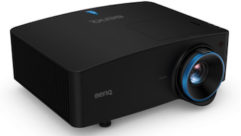
Choosing The Perfect Projector
If you’re in the market for a new projector, you’ll read and hear plenty about brightness and contrast, manual versus power lens, analog and digital input connections, keystone correction, and network interfaces.
Step 3. Exploring lens optionsStep 4. Checking out connector optionsStep 5. Weighing the bells and whistlesStep 6. Credit card, check, or cash?
Here’s where you can get tripped up again. Longer projection throws require longer throw lenses, which have smaller lens apertures than short-throw lenses. That means less light will make it to screen — and even less back to your eyes.
Whatever the brightness specification of your desired projector, it won’t deliver the same performance with longer lenses attached. A short-throw lens with a focal length of 1.3X may have an aperture of 2.0, but a long-throw version might have an aperture of 4.0, which is about two f-stops dimmer.
If your dream projector can deliver 2,500 lumens with a short-throw lens, it’s only going to push 700 lumens through that f4.0 long lens, which means you’ll have to dim the lights or select a model that has 10,000 lumens output (an increase of two f-stops) to hit your brightness target.
There is a big advantage to using longer-throw lenses: less distortion in the horizontal and vertical picture axes. You do give up some depth of field, although that’s hardly a problem when projecting onto a flat screen. But you’ll wind up with an image free of pincushioning and other geometric image distortion.
Over the years, I’ve found that a focal ratio (projection distance to screen width) of 2:1 works very well. It keeps the projector far enough away from the screen to minimize noise, presents images with little geometric distortion, but allows for relatively wide lens apertures (2.0 to 2.6) and preserves image brightness.
Should you buy projectors with fixed or interchangeable lenses? If your projector is going to be installed, then there’s no need for optional lenses — unless that’s the only way you can get the specific focal length you want. Interchangeable lenses are really of value to rental & staging houses. With more projector models now supporting “short zoom” focal lengths (1.5X to 2.5X), the need for interchangeable lenses isn’t as great.
The DVI-D interface is popular for professsional and consumer displays.
This is an easy one, and all you’ll need to do is to sit down and break out your viewing content into categories. Are you connecting images from notebook PCs, workstations, simulators, standard-definition video, or high-definition video?
If you watch a significant amount of standard-definition video, then you’d better be sure your projector is up to the task of de-interlacing, motion compensating, and scaling those video sources. This process becomes trickier as the native resolution of the projector increases — scaling 480-line video to SVGA (800×600) resolution is one thing; yanking it all the way to SXGA+ (1400×1050) is quite another.
In that case, you may want to consider the purchase of an outboard video/data scaler and switcher. These have come way down in price — many models now offer seamless switching from one signal source to another at low prices (either with a clean cut, a dissolve, or a simple fade-to-black followed by a fade-up).
As far as analog and digital interfaces go, don’t settle for any projector unless it has at least one digital (DVI) input. Digital video interfaces are the wave of the future, with both DVI and the consumer HDMI interface appearing on more and more models. If you need to view serial video data streams, check to see if optional SDI and HD-SDI interfaces are available in addition to DVI.
The HDMI connector is included on some professional projectors.
Today’s projectors, it seems, can do everything. Flashcard readers, network interfaces, wireless mice adapters, digital keystone correction — you name it, projectors have it. But you might not need most of that stuff, so why pay more for it?
If you’re installing a projector, the most important option is mechanical lens shift, primarily in the vertical plane. This will allow greater flexibility in projector placement and is infinitely more useful than digital keystone correction, which re-maps pixels across the imaging device and creates aliased edges.
A projector that offers both horizontal and vertical correction is even more desirable, although it’s assumed that you’ll try your best to find the optical centerline in the vertical projection axis when you install your projector.
Network interfaces are a plus if you need to monitor the operation of a projector from a distance, or are responsible for several projectors in a campus environment. But if you’re simply installing a projector in a room for occasional meetings and presentations, there’s probably no need to worry about this feature.
Multi-lamp modes and low-power modes can extend the service cycles of your projector. If the projector is bright enough, a lamp economy mode will let you stretch out a few hundred more hours before re-lamping, saving you some bucks along the way. If the projector is going to get heavy use day in and day out, a dual-lamp setup makes a lot of sense to avoid downtime when lamps fail.
As for the rest of the options being offered, it’s really up to you and how tech-savvy the projector users are. Try as they might, manufacturers still can’t get presenters to leave their notebooks behind and travel to presentation rooms armed only with PCM/CIA memory cards (an idea whose time has come and gone), or even with USB flash memory sticks (a much better idea). Built-in projector mice have also gotten a lukewarm reception. Wireless USB mice for notebooks are so ubiquitous and inexpensive these days that no one really needs them in a projector, and again, presenters are loath to travel anywhere without their super-slim notebook PCs.
Mechanical lens offset is always preferred over digital keystone correction.
Now you’ve got a better idea of how to shop for a new projector. Never buy a projector based on low price or sheer brightness; always do your shopping with a game plan in hand. Figure your screen size, projection throw, and minimum lumens requirement using the information presented earlier to get into the ballpark, and finish up with sensible decisions on lenses, interfaces, and extras like networking and memory card readers.
And follow the manufacturer’s recommendations for projector servicing, cooling, and air filter cleaning. Service department managers tell me the biggest problem they have is with dust and dirt accumulation, inadequate airflow, and failure to follow recommended servicing guidelines. Protect your investment!
Pete Putman is a contributing editor for Pro AV and president of ROAM Consulting, Doylestown, PA. Especially well known for the product testing/development services he provides manufacturers of projectors, monitors, integrated TVs, and display interfaces, he has also authored hundreds of technical articles, reviews, and columns for industry trade and consumer magazines over the last two decades. You can reach him at [email protected].










